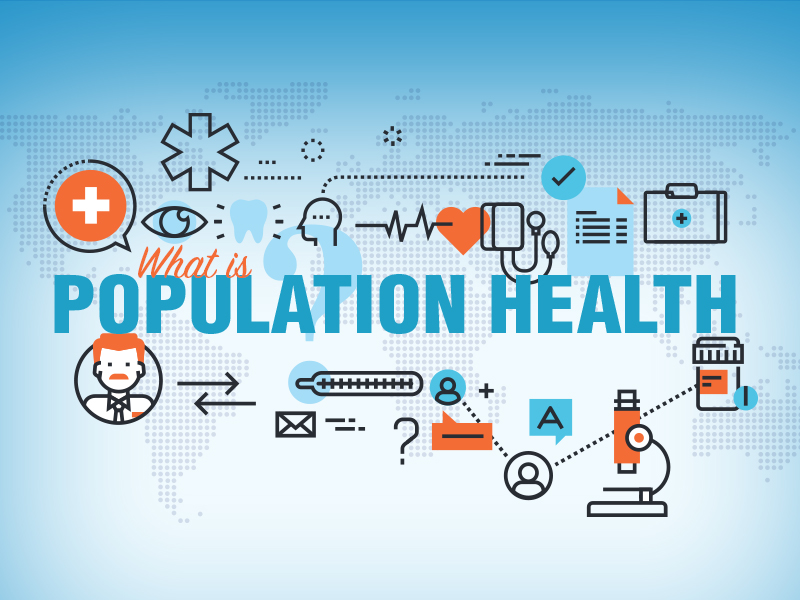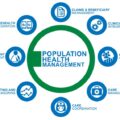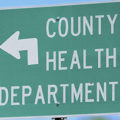Population health is defined as the health outcomes of a group of individuals, including the distribution of such outcomes within the group. These groups are often geographic populations such as nations or communities, but can also be other groups such as employees, ethnic groups, disabled persons, prisoners, or any other defined group. The health outcomes of such groups are of relevance to policymakers in both the public and private sectors.
Note that population health is not just the overall health of a population but also includes the distribution of health. Overall health could be quite high if the majority of the population is relatively healthy—even though a minority of the population is much less healthy. Ideally, such differences would be eliminated or at least substantially reduced.
Population health, as defined above, has been critiqued as being so broad as to include everything—and therefore not very useful in guiding specific research or policy. The truth is, no one in the public or private sectors currently has responsibility for overall health improvement. Policy managers, for example, tend to have responsibility for a single sector while advocacy groups likewise focus on a single disease or factor.
The inherent value of a population health perspective is that it facilitates the integration of knowledge across the many factors that influence health and health outcomes. For population health research, specific investigations into a single factor, outcome measure, or policy intervention are relevant, and may even be critical in some cases–but they should be recognized as only a part and not the whole.
What is the difference between population health and public health?
The distinction between public health and population health deserves attention since it has been at times both confusing and even divisive. Traditionally, public health has been understood by many to be the critical functions of state and local public health departments such as preventing epidemics, containing environmental hazards, and encouraging healthy behaviors.
The broader current definition of the public health system offered by the Institute of Medicine reaches beyond this narrow governmental view. Its report, The Future of the Public’s Health in the 21st Century, calls for significant movement in “building a new generation of intersectoral partnerships that draw on the perspectives and resources of diverse communities and actively engage them in health action .”
However, much of U.S. governmental public health activity does not have such a broad mandate even in its “assurance” functions, since major population health determinants like health care, education, and income remain outside public health authority and responsibility. Similarly, current resources provide inadequate support for traditional–let alone emerging–public health functions. Yet for those who define public health as the “health of the public,” there is little difference from the population health framework of this blog.
In general, Public health works to protect and improve the health of communities through policy recommendations, health education and outreach, and research for disease detection and injury prevention. It can be defined as what “we as a society do collectively to assure the conditions in which people can be healthy” (Institute of Medicine, 1988). On the other hand, population health provides “an opportunity for health care systems, agencies, and organizations to work together in order to improve the health outcomes of the communities they serve.
Why is Population Health Important?
There are a number of reasons why everyone should care about population health. To begin, at the heart of population health is the fact that it is people-focused. The more we can do to improve the health of our fellow humans, the more we lift up all aspects of society (healthier populations can accomplish more than ailing populations, after all), including not having to spend as much money on therapeutic interventions. This assumes that the advances in public health are resulting from improvements in preventative care, diet, and exercise.
There is also a heavy toll to be paid on a nation’s economy when more of its citizens are forced into quarantine or are dying in increased numbers prior to health professionals developing treatments and vaccinations.
People are expecting better care. They are spending more of their earnings on healthcare delivery, from physicians to lab tests to their prescriptions. Medical science must deliver commensurate treatment.
The goal is to provide for better patient satisfaction (on the individual level) while also seeing better health in entire groups as the costs of care go down thanks to efficiencies we realize, in part thanks to improved data collection.
Population health studies lead to our being able to provide improved access to care. And when patients receive care when they need it, instead of later during emergency conditions because of neglect (such as because patients lacked health insurance and use emergency rooms instead of a primary care physician), less stress is placed on these vital services. That benefits everyone.
A focus on population health also promotes better patient engagement. You can expect to see patients feeling empowered so that they can better manage their own health. If you haven’t deployed an online dashboard to help patients communicate with staff and check their latest results, now would be a good time to begin.
Risk Stratification Is a Necessity
Risk stratification involves dividing patients into separate groups which the providers divide according to details such as their medical history, overall lifestyle, and their current health signs, as noted by a report from HIT Consultant.
Risk stratification is seen as necessary for these main reasons:
It helps providers to predict the risks of illness in different groups of patients. Those groups that grow sicker instead of improving their health can be singled out for special attention.
Identifying patient-specific risk factors will help doctors come up with individualized, custom-made care plans instead of resorting to a less effective, one-size-fits-all approach.
With the risks more clearly defined according to different groups, medical care providers can better understand their patient population and therefore determine how to best allocate their resources, from staffing to medications and equipment that must be kept on hand for that particular group.
Healthcare Technology Can’t Do it All
It’s tempting for us to think we can get rely chiefly on our technology, including computers and software systems to take care of much of the drudgery of our daily work requirements. But you should keep in mind that all our healthcare technology cannot replace people and their informed judgment and combined experience in treating members of the public.
While a sophisticated EHR system can be instrumental in helping staff members record and update patient data, it cannot yet make informed decisions or develop any form of custom care regimens based on population data and emerging trends identified by statisticians. This process is in fact still manual and needs to be done by a physician or doctor.
The subject of population health is going to be of increasing importance going forward, especially as more medical practices provide diagnoses and treatment statistics, and other information electronically to public health researchers. Keep in mind that population health by its very nature is focused on people and it involves professionals assessing populations in terms of risk stratification.
Understand Population Health
While software and computer systems play a big role in population health, doctors must be involved in such areas as making decisions and coming up with improved care regimes. If you don’t feel quite up to speed on all things having to do with population health.
Population Health Outcomes
Healthcare professionals partner with populations to improve the health of populations by promoting health, preventing disease, and addressing health inequities. Outcomes include:
- Advocacy to decrease health disparities
- Policy making to address health disparities
- Improving health outcomes of populations in need
- Implementing cost-effective strategies to address health disparities
- Leadership strategies to impact safety, cost, and clinical outcomes
- Executing educational approaches to improve clinical decision-making and evidence-based practice
- Developing practice guidelines





